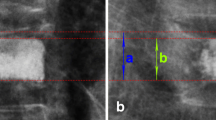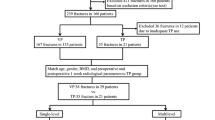Abstract
Summary
This retrospective study compared the efficacy of anabolic agents (romosozumab and teriparatide) with that of alendronate in preventing subsequent vertebral body fractures (SVBFs) after balloon kyphoplasty (BKP). All anabolic agents significantly reduced SVBFs. Romosozumab was most effective in increasing bone mineral density (BMD) and completely suppressed distant vertebral body fractures.
Introduction
To determine optimal anti-osteoporosis medications, we compared romosozumab and teriparatide to alendronate as a control from perioperative BKP to the 1st postoperative year for treatment and secondary fracture prevention in osteoporosis.
Methods
A total of 603 patients who underwent initial BKP for osteoporotic vertebral fractures were evaluated and categorized into five groups based on drug administration: romosozumab (group R, 155 patients), twice-weekly teriparatide (group TW, 48), weekly teriparatide (group W, 151), daily teriparatide (group D, 138), and alendronate (control) (group C, 111). The 1-year incidence of SVBFs, BMD change rate, and probability of requiring BKP were compared among the groups.
Results
SVBF incidence was 3.9%, 6.5%, 8.3%, 6.0%, and 14.4% in groups R, D, TW, W, and C, respectively, with all other groups exhibiting significantly lower rates than group C. The groups that administered the anabolic agents had a notably lower incidence of distant fractures than group C. Compared with group C, group R showed significantly higher BMD change rates in lumbar vertebral bodies at 4, 8, and 12 months and group D at 12 months. Anabolic agent groups exhibited significantly higher improvement rates than group C after conservative treatment alone.
Conclusion
The anabolic agents were found to be more effective at reducing the incidence of SVBF (especially distant vertebral fractures) than alendronate. These agents decreased the rate of repeat BKP even after the occurrence of a fracture. Overall, the use of an anabolic agent for the treatment of osteoporosis after BKP is better than the use of alendronate, even when treatment is initiated in the perioperative stage.




Similar content being viewed by others
Data Availability
The data that support the findings of this study are available from the authors upon reasonable request. A written application stating the purpose of the data to be used must be submitted to the Ethics Committee of our hospital for permission. To maintain patient confidentiality, all data that enable identification of the patient will be deleted.
References
Taylor RS, Fritzell P, Taylor RJ (2007) Balloon kyphoplasty in the management of vertebral compression fractures: an updated systematic review and meta-analysis. Eur Spine J 16:1085–1100. https://doi.org/10.1007/s00586-007-0308-z
Farrokhi MR, Alibai E, Maghami Z (2011) Randomized controlled trial of percutaneous vertebroplasty versus optimal medical management for the relief of pain and disability in acute osteoporotic vertebral compression fractures. J Neurosurg Spine 14:561–569. https://doi.org/10.3171/2010.12.SPINE10286
Phillips FM, Ho E, Campbell-Hupp M, McNally T, Todd Wetzel F, Gupta P (2003) Early radiographic and clinical results of balloon kyphoplasty for the treatment osteoporotic vertebral compression fractures. Spine (Phila Pa 1976) 28:2260–2265. https://doi.org/10.1097/01.BRS.0000085092.84097.7B
Togawa D (2011) Balloon kyphoplasty for primary osteoporotic vertebral compression fractures: Japanese clinical study. J Spine Res 2:1485–1493 (in Japanese)
Bouza C, López-Cuadrado T, Almendro N, Amate JM (2015) Safety of balloon kyphoplasty in the treatment of osteoporotic vertebral compression fractures in Europe: a meta-analysis of randomized controlled trials. Eur Spine J 24:715–723. https://doi.org/10.1007/s00586-014-3581-7
Chen YC, Lin WC (2016) Can anti-osteoporotic therapy reduce adjacent fracture in magnetic resonance imaging-proven acute osteoporotic vertebral fractures? BMC Musculoskelet Disord 17:151. https://doi.org/10.1186/s12891-016-1003-1
Ebeling PR, Akesson K, Bauer DC et al (2019) The efficacy and safety of vertebral augmentation: a second ASBMR Task Force Report. J Bone Miner Res 34:3–21. https://doi.org/10.1002/jbmr.3653
Li HM, Zhang RJ, Gao H et al (2018) New vertebral fractures after osteoporotic vertebral compression fracture between balloon kyphoplasty and non-surgical treatment PRISMA. Medicine (Baltimore) 97:e12666. https://doi.org/10.1097/MD.0000000000012666
Zhang H, Xu C, Zhang T, Gao Z, Zhang T (2017) Does percutaneous vertebroplasty or balloon kyphoplasty for osteoporotic vertebral compression fractures increase the incidence of new vertebral fractures? A meta-analysis. Pain Physician 20:E13–E28
Lunt M, O’Neill TW, Felsenberg D et al (2003) Characteristics of a prevalent vertebral deformity predict subsequent vertebral fracture: results from the European Prospective Osteoporosis Study (EPOS). Bone 33:505–513. https://doi.org/10.1016/s8756-3282(03)00248-5
Committee for the Development of Guidelines for Prevention and Treatment of Osteoporosis (2015) Guidelines for prevention and treatment of osteoporosis 2015 ed. In: Committee for the Development of Guidelines for Prevention and Treatment of Osteoporosis (eds). Tokyo: Life Science Publishing; p 116. (in Japanese)
Kong M, Zhou C, Zhu K et al (2019) 12-month teriparatide treatment reduces new vertebral compression fractures incidence and back pain and improves quality of life after percutaneous kyphoplasty in osteoporotic women. Clin Interv Aging 14:1693–1703. https://doi.org/10.2147/CIA.S224663
Ueno M, Toriumi E, Yoshii A, Tabata Y, Furudate T, Tajima Y (2022) Use of parathyroid hormone and rehabilitation reduces subsequent vertebral body fractures after balloon kyphoplasty. Asian Spine J 16:432–439. https://doi.org/10.31616/asj.2020.0608
Banefelt J, Åkesson KE, Spångéus A et al (2019) Risk of imminent fracture following a previous fracture in a Swedish database study. Osteoporos Int 30:601–609. https://doi.org/10.1007/s00198-019-04852-8
Takahashi S, Hoshino M, Yasuda H et al (2019) Development of a scoring system for predicting adjacent vertebral fracture after balloon kyphoplasty. Spine J 19:1194–1201. https://doi.org/10.1016/j.spinee.2019.02.013
Erkan S, Ozalp TR, Yercan HS, Okcu G (2009) Does timing matter in performing kyphoplasty? Acute versus chronic compression fractures. Acta Orthop Belg 75:396–404
Minamide A, Maeda T, Yamada H et al (2018) Early versus delayed kyphoplasty for thoracolumbar osteoporotic vertebral fractures: the effect of timing on clinical and radiographic outcomes and subsequent compression fractures. Clin Neurol Neurosurg 173:176–181. https://doi.org/10.1016/j.clineuro.2018.07.019
Bouxsein ML, Eastell R, Lui LY et al (2019) Change in bone density and reduction in fracture risk: a meta-regression of published trials. J Bone Miner Res 34:632–642. https://doi.org/10.1002/jbmr.3641
Bergmann PJ (2019) Change in bone density and reduction in fracture risk: a meta-regression of published trials. J Bone Miner Res 34:1976. https://doi.org/10.1002/jbmr.3835
Kanis JA (1984) Treatment of osteoporotic fracture. Lancet 1(8367):27–33. https://doi.org/10.1016/s0140-6736(84)90191-0
Poole KE, Treece GM, Pearson RA et al (2022) Romosozumab enhances vertebral bone structure in women with low bone density. J Bone Miner Res 37:256–264. https://doi.org/10.1002/jbmr.4465
Lyritis G, Marin F, Barker C et al (2010) Back pain during different sequential treatment regimens of teriparatide: results from EUROFORS. Curr Med Res Opin 26:1799–1807. https://doi.org/10.1185/03007995.2010.488516
Tanaka T, Takao-Kawabata R, Takakura A et al (2020) Teriparatide relieves ovariectomy-induced hyperalgesia in rats, suggesting the involvement of functional regulation in primary sensory neurons by PTH-mediated signaling. Sci Rep 10:5346. https://doi.org/10.1038/s41598-020-62045-4
Nagae M, Hiraga T, Wakabayashi H, Wang L, Iwata K, Yoneda T (2006) Osteoclasts play a part in pain due to the inflammation adjacent to bone. Bone 39:1107–1115. https://doi.org/10.1016/j.bone.2006.04.033
Abe Y, Iba K, Sasaki K et al (2015) Inhibitory effect of bisphosphonate on osteoclast function contributes to improved skeletal pain in ovariectomized mice. J Bone Miner Metab 33:125–134. https://doi.org/10.1007/s00774-014-0574-x
Geusens P, Feldman R, Oates M et al (2022) Romosozumab reduces incidence of new vertebral fractures across severity grades among postmenopausal women with osteoporosis. Bone 154:116209. https://doi.org/10.1016/j.bone.2021.116209
Saag KG, Petersen J, Brandi ML et al (2017) Romosozumab or alendronate for fracture prevention in women with osteoporosis. N Engl J Med 377:1417–1427. https://doi.org/10.1056/NEJMoa1708322
Crans GG, Silverman SL, Genant HK, Glass EV, Krege JH (2004) Association of severe vertebral fractures with reduced quality of life: reduction in the incidence of severe vertebral fractures by teriparatide. Arthritis Rheum 50:4028–4034. https://doi.org/10.1002/art.20671
Kitaguchi K, Kashii M, Ebina K et al (2019) effects of weekly teriparatide administration for vertebral stability and bony union in patients with acute osteoporotic vertebral fractures. Asian Spine J 13:763–771. https://doi.org/10.31616/asj.2018.0311
Oishi Y, Nakamura E, Murase M et al (2020) Presence or absence of adjacent vertebral fractures has no effect on long-term global alignment and quality of life in patients with osteoporotic vertebral fractures treated with balloon kyphoplasty. J Orthop Sci 25:931–937. https://doi.org/10.1016/j.jos.2019.12.001
Longo UG, Loppini M, Denaro L, Maffulli N, Denaro V (2004) Osteoporotic vertebral fractures: current concepts of conservative care. Br Med Bull 102:171–189. https://doi.org/10.1093/bmb/ldr048
Wilson DR, Myers ER, Mathis JM et al (2000) Effect of augmentation on the mechanics of vertebral wedge fractures. Spine (Phila Pa 1976) 25:158–165. https://doi.org/10.1097/00007632-200001150-00004
Belkoff SM, Mathis JM, Fenton DC, Scribner RM, Reiley ME, Talmadge K (2001) An ex vivo biomechanical evaluation of an inflatable bone tamp used in the treatment of compression fracture. Spine (Phila Pa 1976) 26:151–156. https://doi.org/10.1097/00007632-200101150-00008
Kayanja MM, Evans K, Milks R, Lieberman IH (2006) Adjacent level load transfer following vertebral augmentation in the cadaveric spine. Spine (Phila Pa 1976) 31:E790–E797. https://doi.org/10.1097/01.brs.0000238690.09903.4c
Inose H, Kato T, Ichimura S et al (2021) Risk factors for subsequent vertebral fracture after acute osteoporotic vertebral fractures. Eur Spine J 30:2698–2707. https://doi.org/10.1007/s00586-021-06741-3
Langdahl BL, Libanati C, Crittenden DB et al (2017) Romosozumab (sclerostin monoclonal antibody) versus teriparatide in postmenopausal women with osteoporosis transitioning from oral bisphosphonate therapy: a randomised, open-label, phase 3 trial. Lancet 390:1585–1594. https://doi.org/10.1016/S0140-6736(17)31613-6
Cosman F, Kendler DL, Langdahl BL et al (2022) Romosozumab and antiresorptive treatment: the importance of treatment sequence. Osteoporos Int 33:1234–1256. https://doi.org/10.1007/s00198-021-06174-0
Ettinger B, San Martin J, Crans G, Pavo I (2004) Differential effects of teriparatide on BMD after treatment with raloxifene or alendronate. J Bone Miner Res 19:745–751. https://doi.org/10.1359/JBMR.040117
World Health Organization (1994) Assessment of fracture risk and its application to screening for postmenopausal osteoporosis: report of a WHO study group (WHO technical report series; 843). World Health Organization, Genova, Switzerland
Cauley JA, Thompson DE, Ensrud KC, Scott JC, Black D (2000) Risk of mortality following clinical fractures. Osteoporos Int 11:556–561. https://doi.org/10.1007/s001980070075
Acknowledgements
We thank Yoshio Makino in the Information System Section of Machida Keisen Hospital for his great contribution to collecting information from the medical records of patients.
Author information
Authors and Affiliations
Corresponding author
Ethics declarations
Ethics approval
This single-center retrospective study was performed with the approval of the institutional review board of Machida Keisen Hospital (Approval Number: 2023–001).
Informed consent
The requirement for obtaining patient informed consent was waived owing to the retrospective nature of this study.
Conflicts of interest
None.
Additional information
Publisher's Note
Springer Nature remains neutral with regard to jurisdictional claims in published maps and institutional affiliations.
Supplementary Information
Below is the link to the electronic supplementary material.
Rights and permissions
Springer Nature or its licensor (e.g. a society or other partner) holds exclusive rights to this article under a publishing agreement with the author(s) or other rightsholder(s); author self-archiving of the accepted manuscript version of this article is solely governed by the terms of such publishing agreement and applicable law.
About this article
Cite this article
Ueno, M., Tajima, Y., Ito, S. et al. Comparative analysis of anti-osteoporosis medications in preventing vertebral body fractures after balloon kyphoplasty. Arch Osteoporos 19, 19 (2024). https://doi.org/10.1007/s11657-024-01374-7
Received:
Accepted:
Published:
DOI: https://doi.org/10.1007/s11657-024-01374-7




